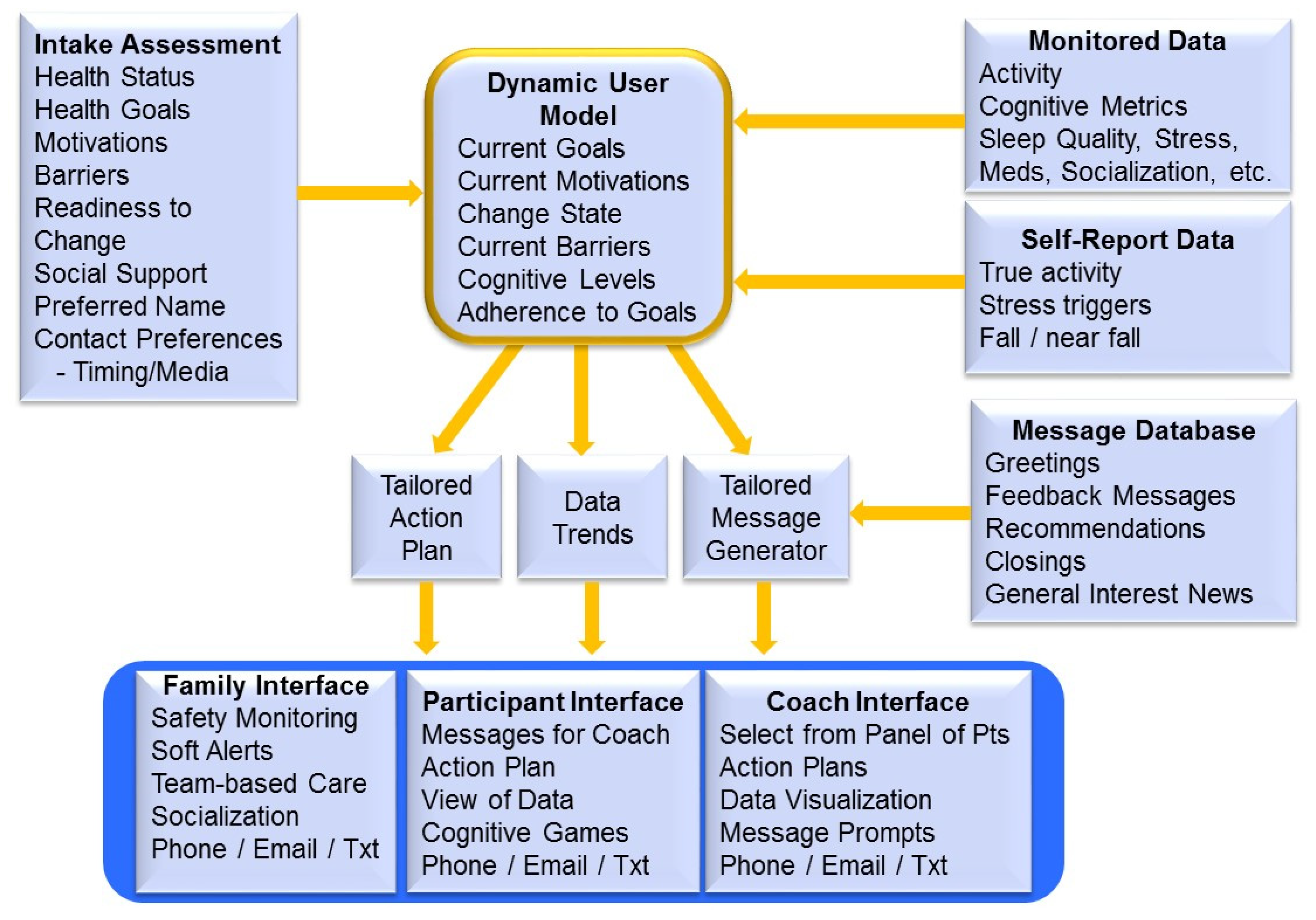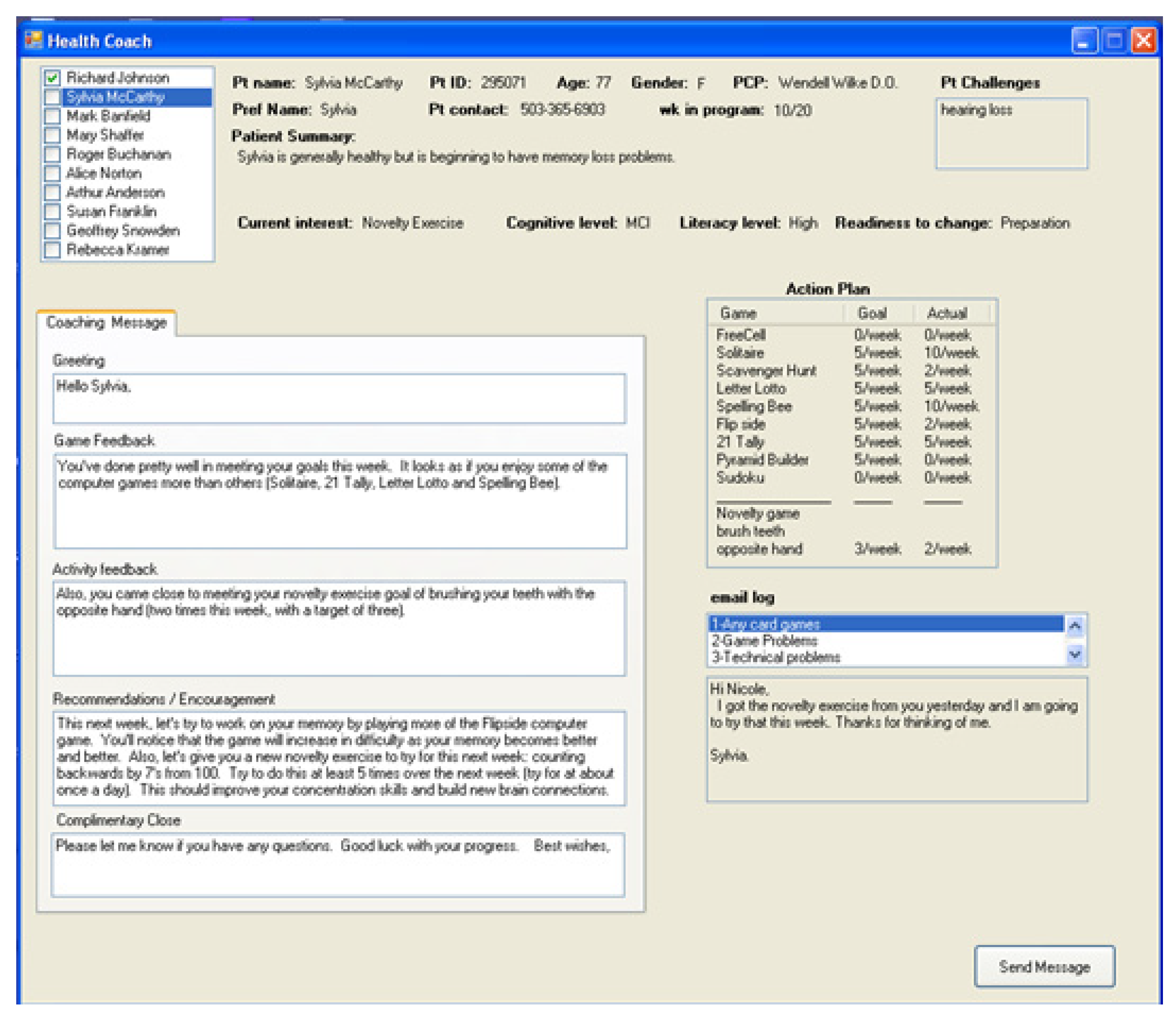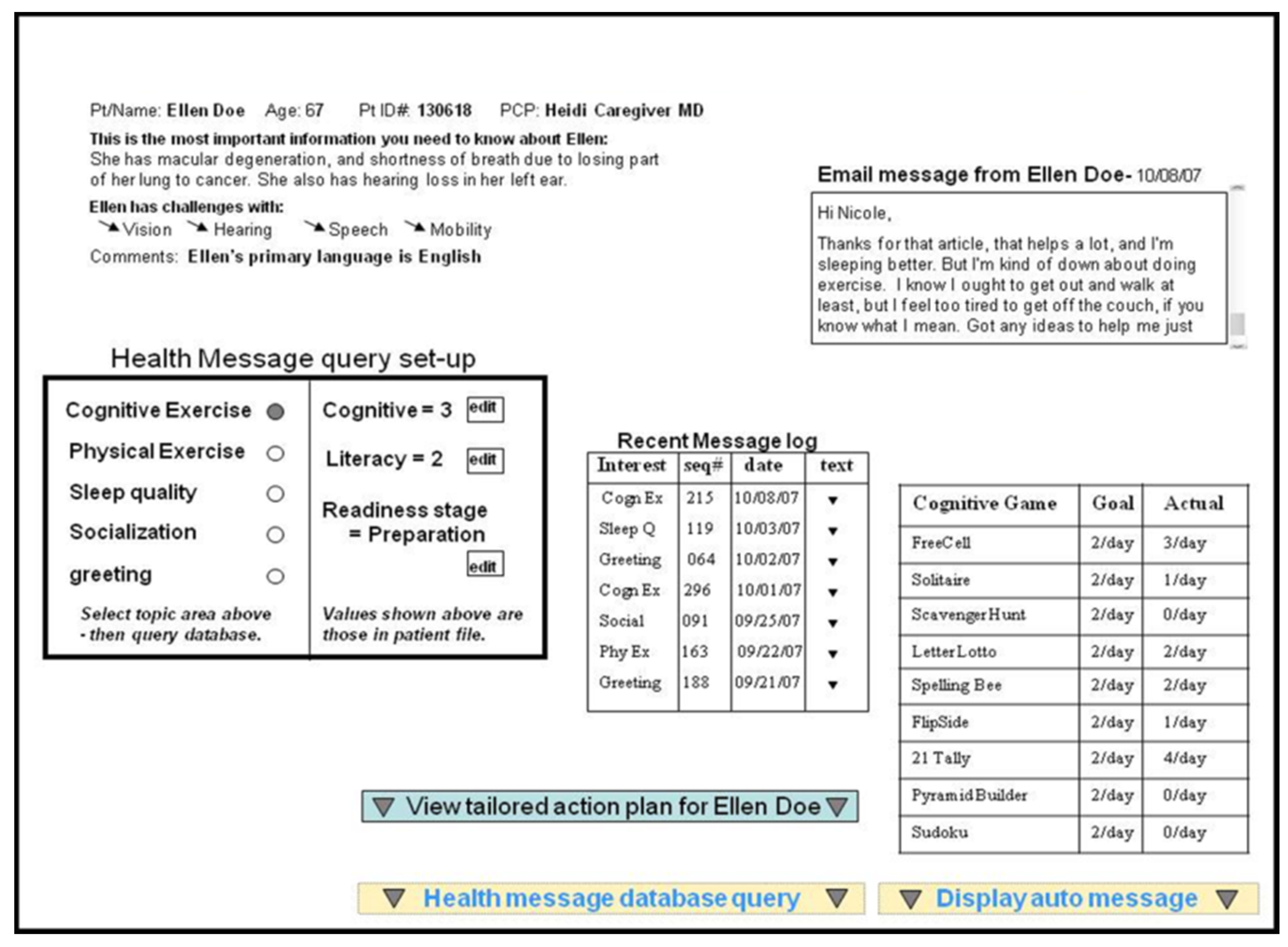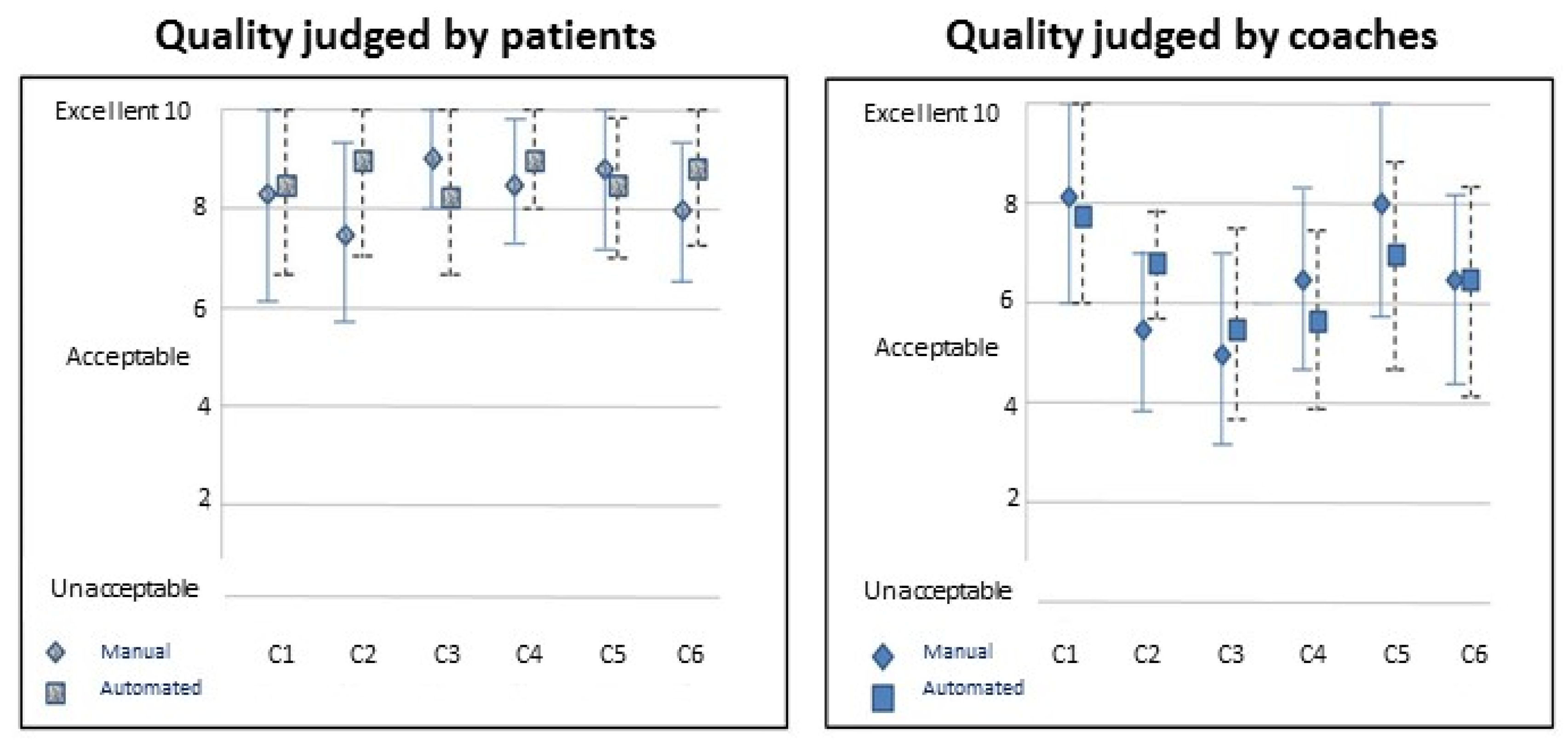Adaptive Health Coaching Technology for Tailored Interventions
Abstract
1. Introduction
2. Materials and Methods
3. Results
3.1. Coach Efficiency
3.2. Message Quality
3.3. Coach Debriefing Findings
- Tone: Messages should never be framed in a negative way. Focus on accomplishments not failures.
- Tailoring/Personalization: Recommendation/suggestions need to be more personalized
- Customization:
- ⚬
- System would be highly useful if “the words were correct” (i.e., their own words framed in the right way)
- ⚬
- Template was helpful–wanted it to be “my template”
- Training: There was consensus that especially at first, it is easier to have automated text in front of you. “When you’re learning, you’re not sure of the tone to take with people, or exactly what to say”
- Structure:
- ⚬
- Having protocols built in to the automated system helped.
- ⚬
- The first sections (feedback on game play and activity) could definitely be automated. (Less concern about tailoring here)
- Efficiency:
- ⚬
- Prompts were “excellent time saver, reminder of what to say.”
- ⚬
- “It didn’t take much time to tweak these messages”
4. Discussion
Limitations
5. Conclusions
Author Contributions
Funding
Institutional Review Board Statement
Informed Consent Statement
Conflicts of Interest
References
- Centers for Disease Control and Prevention. Economic Cost of Chronic Diseases. Available online: https://www.cdc.gov/chronicdisease/about/costs/index.htm (accessed on 10 December 2020).
- Wagner, E.H. Meeting the needs of chronically ill people. BMJ 2001, 323, 945–946. [Google Scholar] [CrossRef] [PubMed]
- Bodenheimer, T.; Lorig, K.; Holman, H.; Grumbach, K. Patient self-management of chronic disease in primary care. JAMA 2002, 288, 2469–2475. [Google Scholar] [CrossRef] [PubMed]
- Committee on Quality Health Care in America. Crossing the Quality Chasm: A New Health System for the 21st Century; Institute of Medicine: Washington, DC, USA, 2001. [Google Scholar]
- Jimison, H.; Gorman, P.; Woods, S.; Nygren, P.; Walker, M.; Norris, S.; Hersh, W. Barriers and Drivers of Health Information Technology Use for the Elderly, Chronically Ill, and Underserved; Evidence Report/Technology Assessment No. 175 (Prepared by the Oregon Evidence-based Practice Center under Contract No. 290-02-0024); AHRQ Publication No. 09-E004; Agency for Healthcare Research and Quality: Rockville, MD, USA, 2008. [Google Scholar]
- Hekler, E.B.; Michie, S.; Pavel, M.; Rivera, D.E.; Collins, L.M.; Jimison, H.B. Advancing models and theories for digital behavior change interventions. Am. J. Prev. Med. 2016, 51, 825–832. [Google Scholar] [CrossRef] [PubMed]
- Rivera, D.E.; Jimison, H.B. Systems modeling of behavior change: Two illustrations from optimized interventions for improved health outcomes. IEEE Pulse 2013, 4, 41–47. [Google Scholar] [CrossRef] [PubMed][Green Version]
- Pavel, M.; Jimison, H.B.; Korhonen, I.; Gordon, C.M.; Saranummi, N. Behavioral Informatics and Computational Modeling in Support of Proactive Health Management and Care. IEEE Trans. Biomed. Eng. 2015, 62, 2763–2775. [Google Scholar] [CrossRef] [PubMed]
- Khaghani-Far, I.; Li, X.; Kos, M.; Gordon, C.M.; Williams, H.; Pavel, M.; Jimison, H.B. NUCoach: A Customizable Coaching Platform for Designing Rehabilitation Mobile Apps. Arch. Phys. Med. Rehabil. 2019, 100, e2. [Google Scholar] [CrossRef]
- Jimison, H.B.; Pavel, M.; Bissell, P.; McKanna, J. A Framework for Cognitive Monitoring Using Computer Game Interactions. In Medinfo 2007, Proceedings of the 12th World Congress on Health (Medical) Informatics; Kuhn, K.A., Warren, J.R., Leong, T.Y., Eds.; Building Sustainable Health Systems; IOS Press: Amsterdam, The Netherlands, 2007. [Google Scholar]
- Seto, E.; Bajcsy, R. Modeling Physical Activity Behavior Change. In Wearable Sensors: Fundamentals, Implementation and Applications; Sazonov, E., Neuman, M.R., Eds.; Elsevier: Amsterdam, The Netherlands, 2014. [Google Scholar]
- Kurillo, G.; Ofli, F.; Marcoe, J.; Gorman, P.; Jimison, H.; Pavel, M.; Bajcsy, R. Multi-disciplinary Design and In-Home Evaluation of Kinect-Based Exercise Coaching System for Elderly. Lect. Notes Comput. Sci. 2015, 9194, 101–113. [Google Scholar] [CrossRef]
- Ofli, F.; Kurillo, G.; Obdrzalek, S.; Bajcsy, R.; Jimison, H.B.; Pavel, M. Design and Evaluation of an Interactive Exercise Coaching System for Older Adults: Lessons Learned. J. Biomed. Health Inform. 2015, 20, 201–212. [Google Scholar] [CrossRef] [PubMed]
- Jimison, H.B.; Hagler, S.; Kurillo, G.; Bajcsy, R.; Pavel, M. Remote health coaching for interactive exercise with older adults in a home environment. In Proceedings of the 2015 37th Annual International Conference of the IEEE Engineering in Medicine and Biology Society (EMBC), Milano, Italy, 25–29 August 2015; Institute of Electrical and Electronics Engineers (IEEE): Piscataway, NJ, USA, 2015. [Google Scholar]
- Hagler, S.; Jimison, H.B.; Bajcsy, R.; Pavel, M. Quantification of human movement for assessment in automated exercise coaching. In Proceedings of the 2014 36th Annual International Conference of the IEEE Engineering in Medicine and Biology Society, Chicago, IL, USA, 26–30 August 2014; pp. 5836–5839. [Google Scholar]
- Pietila, J.; Helander, E.; Myllymaki, T.; Korhonen, I.; Jimison, H.; Pavel, M. Exploratory analysis of associations between individual lifestyles and heart rate variability-based recovery during sleep. In Proceedings of the 37th Annual International Conference of the IEEE Engineering in Medicine and Biology Society, Milan, Italy, 25–29 August 2015. [Google Scholar]
- Jimison, H.B.; Klein, K.A.; Marcoe, J.L. A socialization intervention in remote health coaching for older adults in the home. Proc. IEEE Eng. Med. Biol. Soc. 2013, 2013, 7025–7028. [Google Scholar]
- Li, X.; Jolani, N.; Dao, T.T.; Jimison, H. Serenity: A Low-Cost and Patient-Guided Mobile Virtual Reality Intervention for Cancer Coping. In Proceedings of the 2016 IEEE International Conference on Healthcare Informatics (ICHI), Chicago, IL, USA, 4–7 October 2016; pp. 504–510. [Google Scholar]
- Kos, M.; Gordon, C.M.; Li, X.; Far, I.K.; Pavel, M.; Jimison, H.B. The Accuracy of Monitoring Stress from Wearable Devices. In Proceedings of the American Medical Informatics Association Symposium, Washington, DC, USA, 4–8 November 2017. [Google Scholar]
- Rollnick, S.; Miller, W.R. What is Motivational Interviewing? Behav. Cogn. Psychother. 1995, 23, 325–334. [Google Scholar] [CrossRef]
- Prochaska, J.O.; DiClemente, C.C. The transtheoretical approach. In Handbook of Psychotherapy Integration. Oxford Series in Clinical Psychology, 2nd ed.; Norcross, J.C., Goldfried, M.R., Eds.; Oxford University Press: Oxford, UK; New York, NY, USA, 2005; pp. 147–171. [Google Scholar]
- Shapiro, M. Can an Automated Tailored Health Coaching Messaging System Be an Effective Tool for the Health Coaching of Older Adults? Available online: https://digitalcollections.ohsu.edu/concern/etds/g158bh52r?locale=en (accessed on 10 December 2020).




Publisher’s Note: MDPI stays neutral with regard to jurisdictional claims in published maps and institutional affiliations. |
© 2021 by the authors. Licensee MDPI, Basel, Switzerland. This article is an open access article distributed under the terms and conditions of the Creative Commons Attribution (CC BY) license (http://creativecommons.org/licenses/by/4.0/).
Share and Cite
Jimison, H.; Shapiro, M.; Pavel, M. Adaptive Health Coaching Technology for Tailored Interventions. Int. J. Environ. Res. Public Health 2021, 18, 2761. https://doi.org/10.3390/ijerph18052761
Jimison H, Shapiro M, Pavel M. Adaptive Health Coaching Technology for Tailored Interventions. International Journal of Environmental Research and Public Health. 2021; 18(5):2761. https://doi.org/10.3390/ijerph18052761
Chicago/Turabian StyleJimison, Holly, Michael Shapiro, and Misha Pavel. 2021. "Adaptive Health Coaching Technology for Tailored Interventions" International Journal of Environmental Research and Public Health 18, no. 5: 2761. https://doi.org/10.3390/ijerph18052761
APA StyleJimison, H., Shapiro, M., & Pavel, M. (2021). Adaptive Health Coaching Technology for Tailored Interventions. International Journal of Environmental Research and Public Health, 18(5), 2761. https://doi.org/10.3390/ijerph18052761





